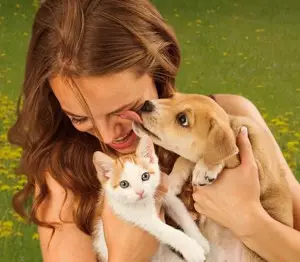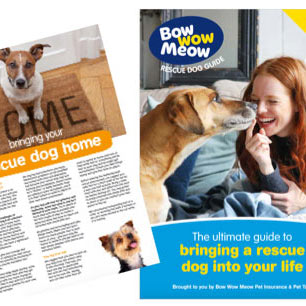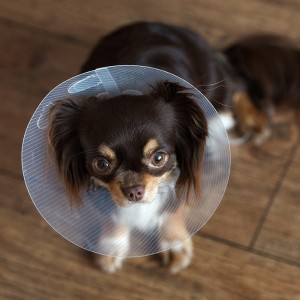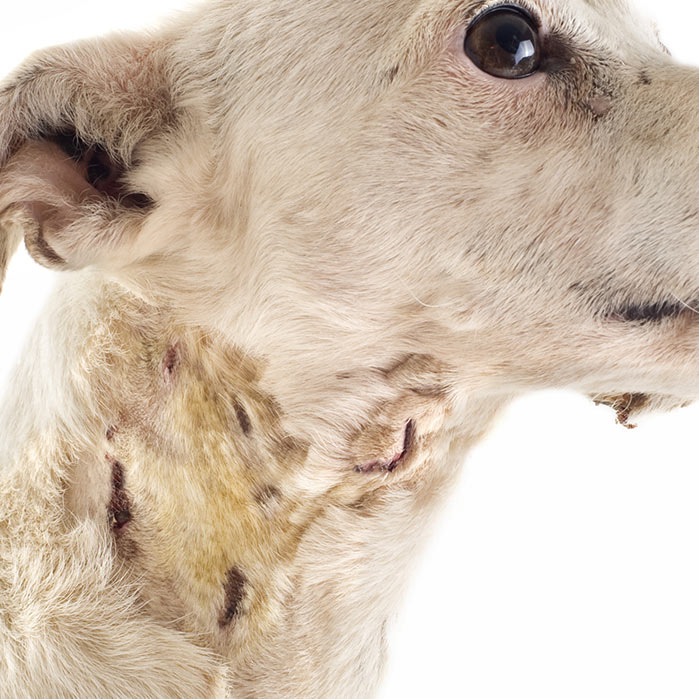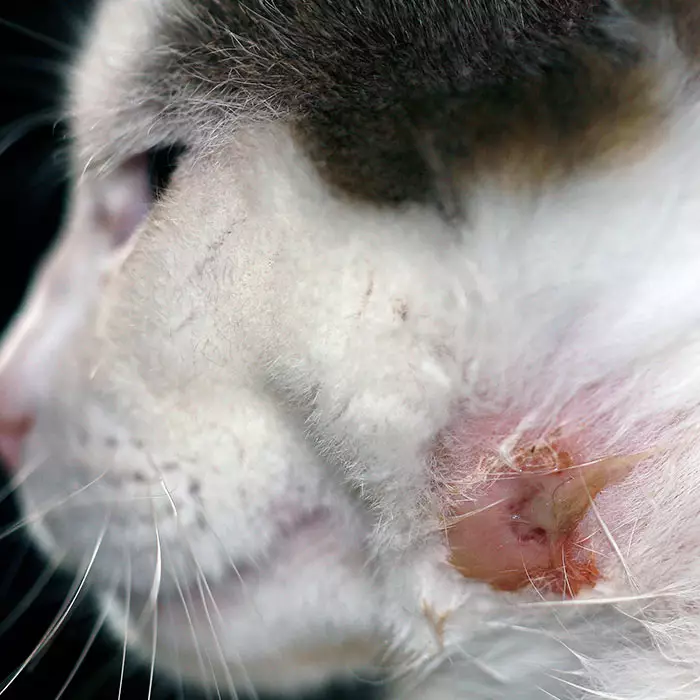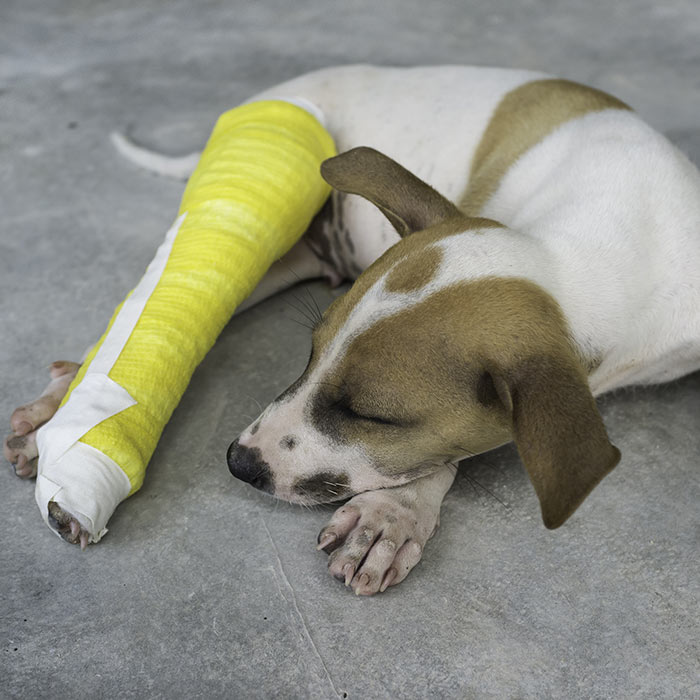Wounds in dogs and cats
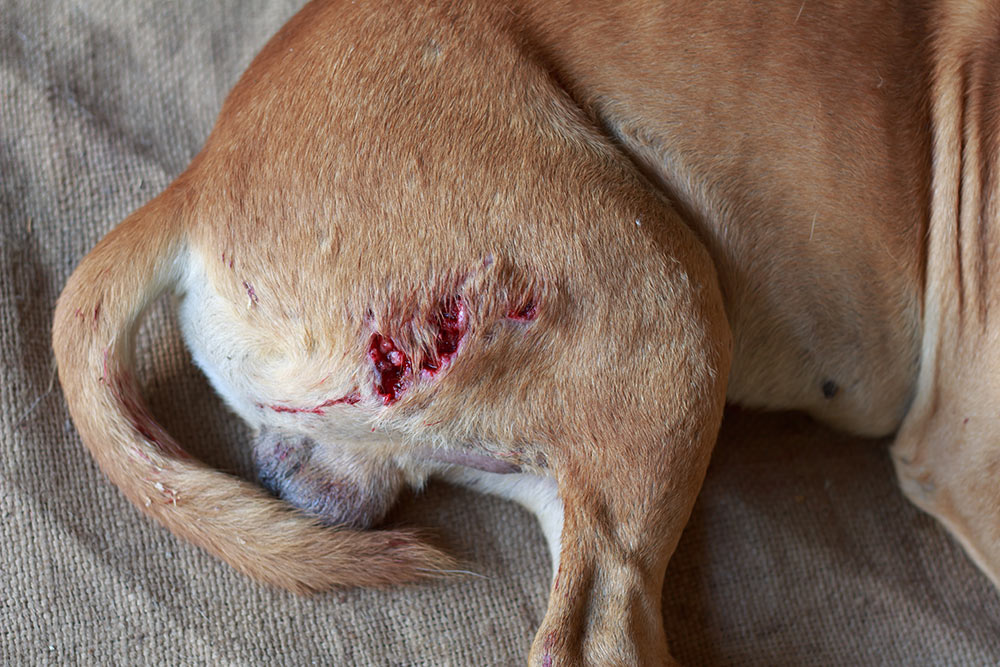
A wound is damaged tissue, such as a cut, bruise, tear, burn or break on the skin surface or deeper within the body. Wounds in dogs and cats are generally caused by hard or sharp objects, vehicles or other animals. A wound may be open (e.g. a tear or puncture) or closed (e.g. a bruise). While some wounds are very visible, others, such as puncture wounds caused by sharp teeth, may be hidden by fur, which can make them difficult to detect.
A bite wound from another animal can cause significant damage to the skin and/or underlying soft tissue. Bacterial infections often occur at the wound site where the skin has been broken. Bite wounds, which introduce bacteria from the biter’s mouth under the victim’s skin, are particularly susceptible to infection. If left untreated, a contaminated wound – even a very small one – may lead to the spread of infection to other parts of the body that could ultimately be life-threatening.
To avoid complications setting in, it is vital to promptly obtain veterinary attention for any wound. The aims of treatment are to promote healing and to reduce the severity of any infection that develops. Management of the wound depends on the characteristics of the wound, with some wounds being serious enough to require surgery and others needing only minimal treatment. Antibiotics are often used to combat or prevent infection.
Continue reading to learn more about wounds, or jump ahead to:
- Symptoms of wounds in dogs and cats
- Causes of wounds in dogs and cats
- Diagnosis of wounds in dogs and cats
- Prognosis
- Treatment for wounds in dogs and cats
What is a wound?
A wound is any damage to living tissue caused by a cut, blow or other impact. Wounds can be described as open or closed. An open wound has an opening in the skin, such as a cut, tear or puncture, while a closed wound is typically a contusion or bruise that does not have a skin opening. Wounds may be classified as clean, contaminated or infected, depending on the number of pathogenic organisms or bacteria present.
Contaminated and infected wounds are often the consequence of motor vehicle accidents or fights with other animals. Any break in the skin is vulnerable to bacteria which can cause an infection. Damage to muscles, tendons and other vital structures of the body can also occur with deep wounds.
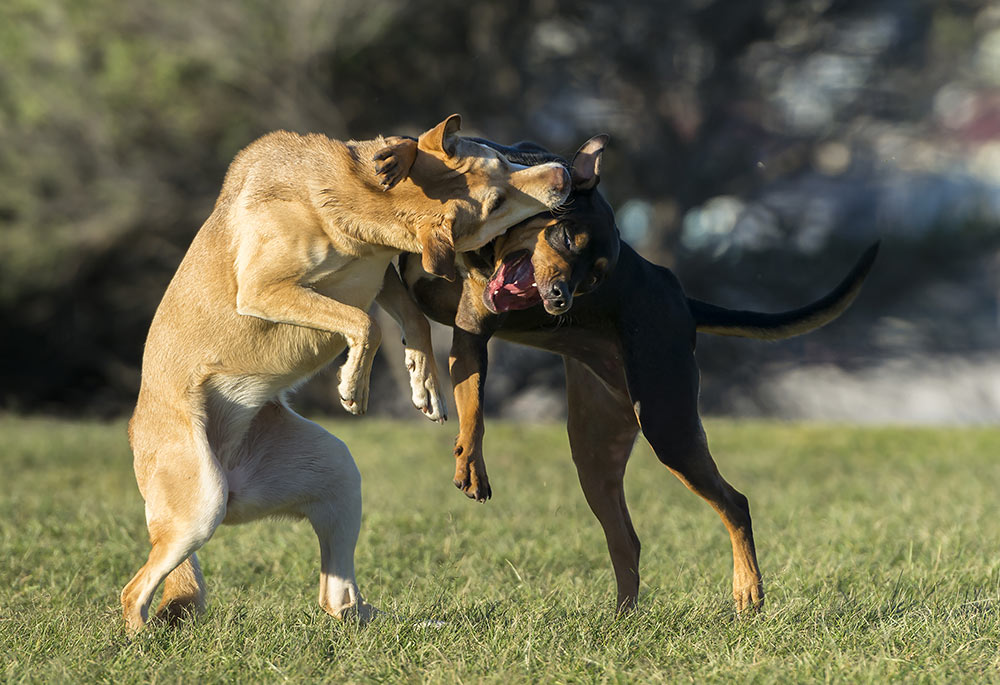
Bite wounds
One of the most common reasons for emergency veterinary appointments for dogs and cats are bite wounds. A dog bite can cause a significant wound to the skin and underlying soft tissues. Dogs’ teeth and jaws are very powerful and can crush or tear muscles and skin and even penetrate through the chest wall and damage the lungs or intestinal organs. As dogs’ mouths are full of bacteria, any bite that does puncture the skin will introduce bacteria or other infectious organisms below the skin surface, where the bacteria can multiply and spread throughout the underlying tissues. For this reason, all bite wounds are regarded as contaminated and/or infected.
Left untreated, the bacteria in an infected wound may cause:
- A localised abscess
- A more generalised cellulitis (tissue infection) that spreads through the surrounding area
- Septic arthritis (infection of the joint space)
- Osteomyelitis (infection of the bone)
- Septic peritonitis (pus in the abdominal cavity)
- Pyothorax (pus in the chest cavity)
Cost of wounds from fights or bites for dogs and cats
Wounds from fights or bites were the fourth most common health issue experienced by both dogs and cats in 2024, according to PetSure claims data. Where possible, keep cats indoors in a cat friendly enclosure and when introducing them to new cats, do so carefully and with caution.
| Claims data for wounds from fights or bites | Average cost of treatmentØ | Highest cost of treatmentØ |
| Dogs | $836 | $46,525 |
| Cats | $620 | $24,529 |
ØBased on PetSure claims data, 2024 calendar year. Reimbursement for these claims under a pet insurance policy would be subject to limits, such as annual benefit limits or sub-limits, benefit percentage, applicable waiting periods and any applicable excess. Cover is subject to the policy terms and conditions. You should consider the relevant Product Disclosure Statement or policy wording available from the relevant provider. Please note that values calculated are based on all claims for that condition and medically related conditions in each calendar year.
Because it is difficult to predict the costs of veterinary care, it can help to have measures in place to help prepare for the unexpected. Pet insurance can help by covering a portion of the eligible vet bill if the unexpected does happen.
Get a quote for 2 months free pet insurance for your puppy or kitten in their first year.
Symptoms of wounds in dogs and cats
Symptoms of a fresh wound may include:
- Bleeding
- Swelling
- Missing or matted hair
- Cut, scraped or torn skin
- Bruising
- Tenderness or pain
Symptoms of infected wounds include:
- Swelling, redness and heat in the area
- Tenderness or pain
- Discharge (pus) from the wound
- Abscess (an accumulation of pus under the skin)
- Hole in the skin where an abscess breaks open and drains
- Excessive grooming of the area (witnessed in cats in particular)
- Fever
- Lethargy
- Reluctance to move
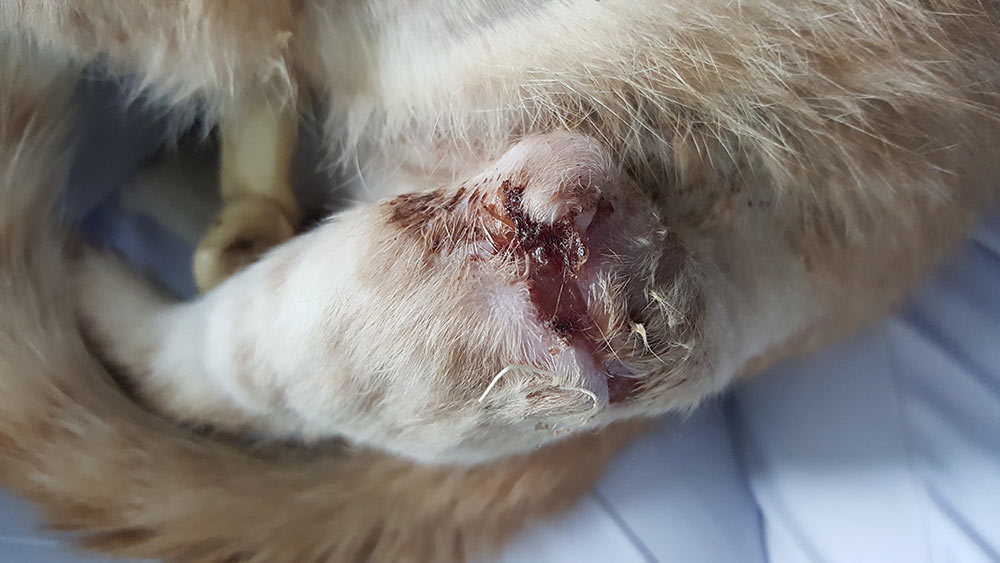
There are certain symptoms that signal the need for immediate emergency treatment. These include:
- Uncontrollable bleeding (bleeding that cannot be stopped)
- Breathing difficulty
- Weakness
- Collapsing
- Crying or whining
- Limping
- Pale or blue gums
Causes of wounds in dogs and cats
Wounds in dogs and cats can have many different causes and can be classified accordingly:
- Laceration or tear – occurs when the skin is cut or torn open, for example by catching on a wire fence or being bitten or scratched by another animal.
- Abrasion, graze or scrape – occurs when the superficial skin layers are scraped off, for example by a sliding fall or being dragged across a rough surface such as a tarred or gravel road.
- Puncture wound – caused by an object puncturing the skin, such as a splinter, nail or needle.
- Incision – caused by a clean, sharp-edged object such as knife, razor or piece of glass.
- Penetration wound – occurs when an object such as a knife or tooth enters and comes out from the skin, leaving a small hole on the surface.
- Gunshot wound – caused by a bullet penetrating the body, resulting in deep wounds and blunt force trauma.
- Pressure sore – prolonged pressure on an area of skin (common in paralysed or immobile animals).
- Degloving injury – extensive loss of skin from being forcefully dragged, for example after being hit by a vehicle.
- Haematoma (or blood tumour) – a closed wound caused by damage to a blood vessel, causing blood to collect under the skin.
- Crush injury – a closed wound caused by an extreme amount of force applied over a long period of time.
How are wounds in dogs and cats diagnosed?
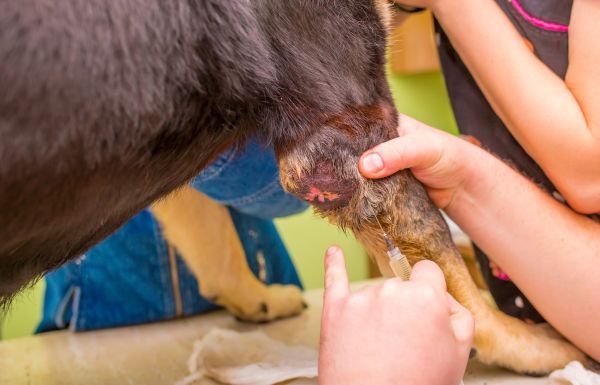
It can be difficult for a non-medical person to observe a wound in a heavily furred area of the body, particularly small wounds such as puncture wounds from a bite. Wounds that appear to be minor on the surface can be deceptive and may have the potential to be life threatening, depending on the severity and location of the injury. If a wound is detected or suspected, it is important that veterinary attention is sought out promptly.
The veterinarian will carefully examine the dog or cat and evaluate all wounds that are found, along with looking for any indications of other problems. The assessment process typically involves several stages:
- Obtaining a detailed medical history, including any medical conditions that may affect the animal’s ability to heal or fight infection.
- Consideration of the cause of the wound (e.g. barbed wire, dog bite, infection).
- Detailed investigation of the wound – this may require sedation or a short anaesthetic in order to allow the veterinarian to fully explore the wound. The animal’s hair may need to be shaved off for proper evaluation. Some wounds may require X-rays.
- Samples (biopsies) may be taken for laboratory examination and culture to identify any bacteria that may be present.
- Blood tests should be performed after any cat bite wound to test for possible infections. Bite wounds from cat to cat are the main avenue of transmission of some serious feline infections, including Feline Immunodeficiency Virus (FIV) and Feline Leukaemia Virus (FeLV).
- Ongoing re-assessment of the wound may be necessary in the initial stages of treatment.
Prognosis
The prognosis for a wound in dogs and cats depends on many factors, including the severity of the wound, the promptness of diagnosis and treatment, and the age and overall health of the animal.
Another important factor is the area of the body that sustains the injury, with mortality occurring more frequently where there is a wound to the thoracic (chest) and abdominal areas. However, in most non-life-threatening cases, the dog or cat should make a complete recovery provided prompt and proper treatment is obtained.
Treatment for a wound in dogs and cats
The basic goals of wound treatment in dogs and cats are to prevent infection and to promote healing. After the initial assessment, the veterinarian will determine the treatment method that will obtain the best and fastest result, based on the location of the wound, the extent of the injury and the animal’s general health.
Management of wounds often requires careful assessment on a day-to-day basis and the treatment plan will need to be flexible in order to allow the veterinarian to adapt it to any changes that occur in the wound.
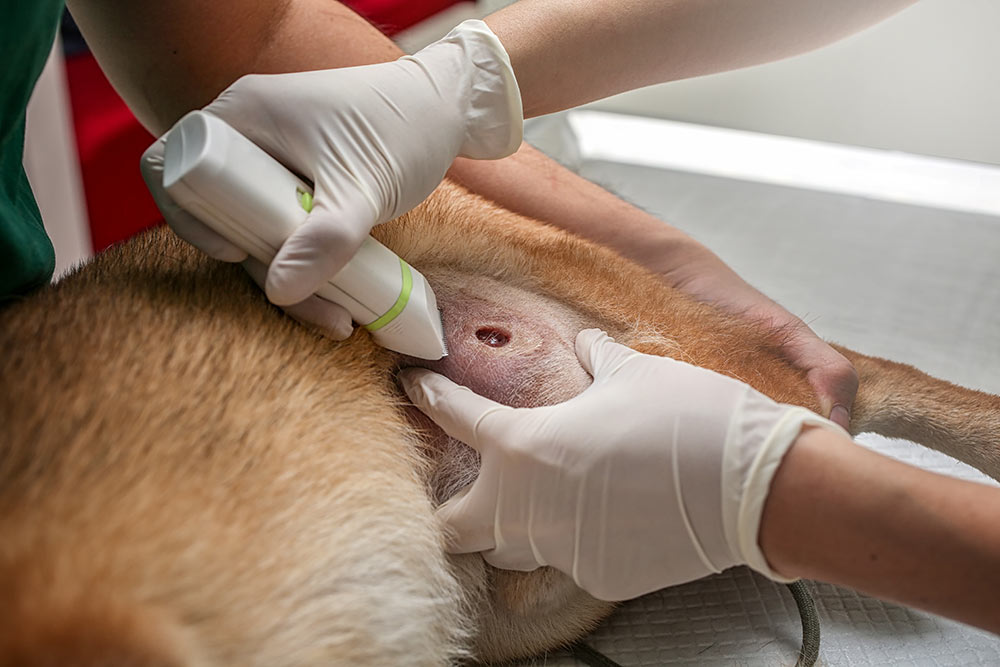
First aid:
First aid care is vital to the successful healing of a wound. Techniques such as using pressure to stop bleeding and basic bandaging should be done quickly; these often need to be performed by the owner immediately after discovering the wound and before consulting the veterinarian. The most important considerations are to keep the wound moist and as clean as possible.
First aid for an open wound entails:
- Controlling the bleeding by holding a piece of clean material over the site and applying pressure for 3 minutes.
- Flushing with saline or clean salty water (1 teaspoon of salt in 600ml of water).
- Applying a sterile bandage, if possible.
To create your own first aid kit for pets, check out this article.
Veterinary treatment:
Veterinary wound treatment begins after the animal has been stabilised if it has undergone a trauma or is in shock. In many cases, the animal will require pain medication, sedation or anaesthetic to assess and treat the wound effectively, without causing more pain. The fur surrounding the wound will usually be shaved to prevent contamination.
Most cuts, bruises and scrapes are not life threatening and will heal with minimal treatment. However, some wounds can be serious enough to require surgical care. Depending on the type and severity of wound, veterinary treatment options may include:
Irrigation of the wound :
Wound lavage, or flushing, decontaminates the wound by washing away both gross (visible) and microscopic debris. Gross debris may include gravel, soil, hair and plant material, while microscopic debris consists of bacteria. A syringe is used to spray a sterile solution onto or into the wound to clean it. This procedure significantly reduces the risk of bacterial infection.
Debridement, removal of dead tissue:
Removal of devitalised (dead) tissue from the wound encourages rapid onset of wound healing by reducing the amount of dead material the white blood cells must remove from the wound. Special debridement bandages or surgical tissue resection can be used and may need to be repeated multiple times and over several days to be effective. Most lacerations are debrided by cutting away any infected or compromised skin tissue and trimming the edges of the laceration.
Collecting a tissue sample:
If the wound is already infected, a tissue sample may be collected for culture and sensitivity testing to determine the type of bacteria involved and the best antibiotics to treat these bacteria. As it takes a few days to get the test results, the veterinarian may only perform these tests if the wound does not respond appropriately to initial broad-spectrum antibiotic treatment.
Managing an open wound:
After initial inspection, irrigation, and cleaning, the veterinarian will decide whether to close the wound or to manage it as an open wound. Each wound must be assessed individually. However, if there is too little skin to close the wound, an active bacterial infection is present, or the risk of infection is high, the wound may benefit from management as an open wound (without suturing) by means of debridement and special dressings.
Specialised wound dressings:
Selecting the right dressing for a wound is crucial in promoting wound healing. If the incorrect dressing is used, infection, delayed healing, or injury to deeper tissues and organs are possible. The correct wound dressing is one that is appropriate for the stage and type of wound. In some cases, hydrogel ointment may be used under dressings to help keep the wound moist and protected. Types of dressings include:
- Wet-to-dry dressings – help clean the wound at every bandage change. In the early stages of healing, the bandage may need to be changed as much as twice daily.
- Dry, non-stick dressings – used after healing has progressed.
- Active dressings – include a component such as alginate, manuka honey, sugar and silver to drain exudate (fluid or pus) away from the wound surface.
- Debridement dressings – wounds that are left open are usually managed with repeated bandaging and debridement.
Surgical repair (closure of the wound):
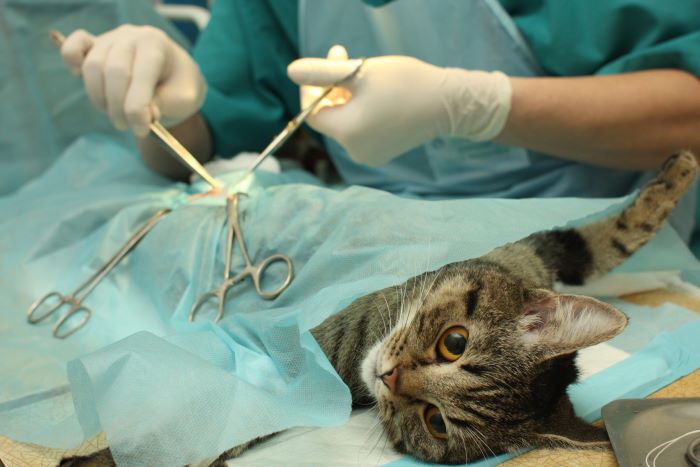
Sutures, staples, or surgical glue can be used to close the wound; for some injuries, layers of closure may be necessary. An open wound may be closed after it has been treated for some time. This is common after an infection is successfully treated with antibiotics. Such wounds may be closed after 24 to 72 hours or longer. Surgical repair may take the form of:
- Direct closure – following successful treatment of tissue damage and infection, the wound is closed with sutures, staples or surgical glue in the operating theatre.
- Free skin grafts – skin is taken from a healthy area of the body and surgically attached to cover the wound.
- Reconstructive techniques – there are a wide range of skin reconstructive techniques, involving the use of different types of skin flaps.
- Drains – a surgical drain (Penrose drain) is a soft, flexible rubber tube that allows excess, contaminated tissue fluid to drain out of the wound. This may be sutured into place under the skin near the wound.
Medication:
Antibiotics are used to treat bacterial infections as well as to prevent them from occurring, particularly where there is a bite wound. The sooner antibiotics are begun after a bite injury, the best chance there is of healing without complications. For minor injuries, or for wounds that must be left open to heal, a topical antibiotic may be prescribed. Medications for pain relief are often prescribed, most typically non-steroidal anti-inflammatory drugs (NSAIDs).
Veterinary surgeons typically manage wounds with a combination of the above treatment methods, as determined by the type and severity of the injury, for example:
- Small scrapes and cuts: These often require only a thorough cleaning and, in some cases, a little skin glue to hold the edges of the cut together.
- Long and/or deep cuts: These require meticulous cleaning to be sure there is no debris in the wound and careful examination to determine the extent of the damage. Often, skin wounds are enlarged to allow the underlying tissues to be thoroughly examined and cleaned. If the wound is less than 12 hours old and not heavily contaminated, it will probably be sutured closed. Temporary drains may be placed in the wound if the damage is extensive, or if there is a chance that fluid will build up in the area.
- Puncture wounds, especially from animal bites: These often cause extensive damage under the skin that may not be visible on initial examination. Foreign material is removed from the wound before it is thoroughly probed and then carefully cleaned with large volumes of antiseptic solution. Sometimes these wounds are surgically opened to treat damage deep in the tissues.
Puncture wounds are usually not sutured but left open so that any infection can drain out. They may be bandaged until such time as the wound is healed or the wound is healthy enough that sutures will help the wound rather than trap infection inside. This form of treatment may also be used for wounds that are over 12 hours old, contaminated or showing signs of infection, abscessed, or missing large amounts of skin.
- Large or deep wounds, contaminated wounds, or multiple puncture wounds: These often require the use of a Penrose drain for 3 to 5 days to prevent the build-up of fluid in the wound. Antibiotics and pain medication are usually prescribed.
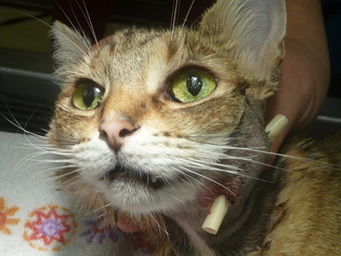
In summary
Wounds are cuts, tears, burns, breaks, or other damage to living tissue. In an open wound, the skin is torn, punctured or broken, while in a closed wound, trauma from a blunt force results in a contusion or bruise. Wounds in dogs and cats are typically caused by hard or sharp objects, collisions with cars and fights with other animals. While some wounds are very visible, others, such as puncture wounds, may be hidden by fur and barely noticeable.
Bacterial infections are a very common consequence of a wound. The goals of treatment are to promote healing and to reduce the severity of any infection that develops. The wound will be thoroughly cleaned, and any dead or severely damaged tissue will be removed. Some will be surgically closed, and others managed as open wounds. Antibiotic medications are also used to combat infection.
More information
- https://www.vetwest.com.au/pet-library/wounds-and-grazes-and-fight-injuries
- https://www.vetwest.com.au/pet-library/fighting-wounds-and-infections-the-fighting-spirit
- https://www.petmd.com/cat/emergency/accidents-injuries/e_ct_wound_treatment
- https://www.willows.uk.net/specialist-services/pet-health-information/soft-tissue/wound-management
- https://www.msdvetmanual.com/special-pet-topics/emergencies/wound-management
- https://vcahospitals.com/know-your-pet/bite-wounds-in-dogs
Bow Wow Meow Pet Insurance can help protect you and your pet should an unexpected trip to your vet occur.
- Find out more about our dog insurance options
- Find out more about our cat insurance options
- Get an instant online pet insurance quote
Bow Wow Meow is proud to have been awarded winner of Canstar’s ‘Most Satisfied Customers’ Award in the Pet Insurance category for both 2024 and 2025!
Bow Wow Meow is proud to have been chosen as Product Review’s Pet Insurance Award Winner every year from 2018 to 2025! This is based on 2,995 independent customer reviews (as at 21/01/2025), with an overall rating of 4.3*
Google Review rating = 4.5* (based on 968 reviews)
Trust Pilot rating = 4.6* (based on 531 reviews)
Bow Wow Meow is proud to have been chosen as Product Review’s Pet Insurance Award Winner every year from 2018 to 2025! This is based on 2,995 independent customer reviews (as at 21/01/2025), with an overall rating of 4.3*
Google Review rating = 4.5* (based on 968 reviews)
Trust Pilot rating = 4.6* (based on 531 reviews)
Bow Wow Meow has been chosen as a winner in the Finder Pet Insurance Awards 2024. Finder’s panel of experts analysed over 140 quotes to award our Ultimate Care Plan the winner of the “Pet Insurance – Value” category.

